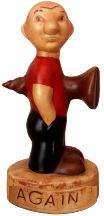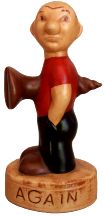 |
 The Virtual Corkscrew Museum's Weekly Newspaper |
 |
 |
 The Virtual Corkscrew Museum's Weekly Newspaper |
 |
|
Sunday, August 6, 2006 |
London Bridge Corkscrews
by Don Bull
London, England - The Internet is replete with information about London bridge with bits and pieces duplicated on numerous sites. Significant facts extracted are:
AD 46: The first bridge across the Thames in the London area was built by the Romans on the present site. It was made of wood.
1014: The bridge was burned down by King Ethelred (the inspiration for the nursery rhyme London Bridge is Falling Down).
1091: A storm destroyed a rebuilt bridge.
1136: Fire destroyed a rebuilt bridge.
1176: Construction of a stone bridge began and was completed in 1208.
1824-1831: A new bridge was built 100 feet upstream from the the old bridge.
1832: The old bridge was torn down and eventually the oak and iron pilings were removed. That's where the corkscrew part of story begins.
This corkscrew appears in the1981 Corkscrews for Collectors by Watney and Babbidge with these details:
"...in a unique rachet-and-pawl design by J. Ovenston of Titchfield Street, London, for which he used oak and iron taken from a pile that was 650 years in the foundations of London Bridge. The old structure was demolished in 1831, when the new bridge was opened by King William IV. Presumably this corkscrew dates from about that time and, if so, both the bow springs and the ratchet and pawl predate the patents for these mechanisms, in the latter case by twenty-five years."
The photo caption notes that the corkscrew has an inscription stating that it was made from a pile in the foundations of the bridge.
Alf Erickson pictures this corkscrew in his 1997 Best Six. The handle is identical to the corkscrew in the Watney / Babbidge book. Alf offers this description:
"This is an English 19th century polished steel two-pillar corkscrew with a turned oak handle bearing a rolled gold shield-shaped plaque inscribed with, 'This handle is part of an Oak Pile that was for 656 years under the London Bridge'. The two pillars are inscribed, 'The Iron Shoe of an Oak Pile that was 656 years in the foundation of Old London Bridge'."
I recently completed a multi-corkscrew trade with Howard Luterman that was ten months in the deal-making (August 2004 - June 2005). One of the corkscrews from Luterman is pictured above (with short worm!).
The inscription on one side of the corkscrew is, "Made from the Iron Shoe of the Oak Pile that was 656 Yrs in the Foundation of London Bridge."
The inscription on the reverse is, "Put down in 1176. I Ovenston, 72 Gt Titchfield St. London Fecit, Taken up in 1832."
This corkscrew is clearly inscribed I. Ovenston not J. Ovenston. Fecit is from the Latin meaning "done by" or "made by". Fecit or simply the letter F is frequently found on coins after the name of an individual who is the engraver of the coin. It is also used in conjunction with other engravings.
The unknown, therefore, is whether or not Ovenston actually made these corkscrews or did he only engrave the inscriptions?
Are there more London Bridge corkscrews?
|
©2006 Don Bull, Editor |